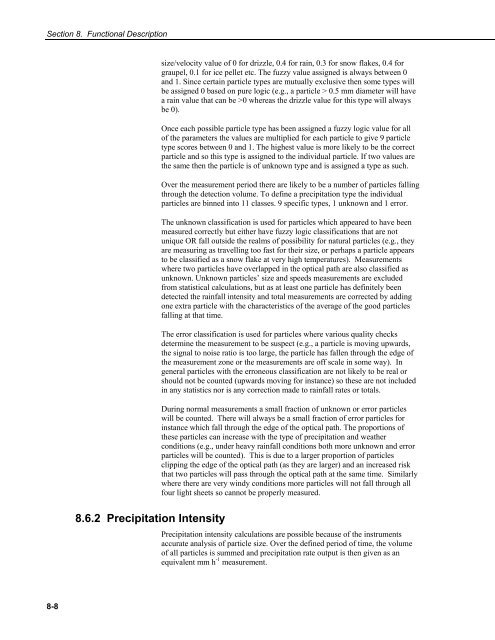PWS100 Present Weather Sensor - Campbell Scientific
PWS100 Present Weather Sensor - Campbell Scientific
PWS100 Present Weather Sensor - Campbell Scientific
Create successful ePaper yourself
Turn your PDF publications into a flip-book with our unique Google optimized e-Paper software.
Section 8. Functional Description<br />
size/velocity value of 0 for drizzle, 0.4 for rain, 0.3 for snow flakes, 0.4 for<br />
graupel, 0.1 for ice pellet etc. The fuzzy value assigned is always between 0<br />
and 1. Since certain particle types are mutually exclusive then some types will<br />
be assigned 0 based on pure logic (e.g., a particle > 0.5 mm diameter will have<br />
a rain value that can be >0 whereas the drizzle value for this type will always<br />
be 0).<br />
Once each possible particle type has been assigned a fuzzy logic value for all<br />
of the parameters the values are multiplied for each particle to give 9 particle<br />
type scores between 0 and 1. The highest value is more likely to be the correct<br />
particle and so this type is assigned to the individual particle. If two values are<br />
the same then the particle is of unknown type and is assigned a type as such.<br />
Over the measurement period there are likely to be a number of particles falling<br />
through the detection volume. To define a precipitation type the individual<br />
particles are binned into 11 classes. 9 specific types, 1 unknown and 1 error.<br />
The unknown classification is used for particles which appeared to have been<br />
measured correctly but either have fuzzy logic classifications that are not<br />
unique OR fall outside the realms of possibility for natural particles (e.g., they<br />
are measuring as travelling too fast for their size, or perhaps a particle appears<br />
to be classified as a snow flake at very high temperatures). Measurements<br />
where two particles have overlapped in the optical path are also classified as<br />
unknown. Unknown particles’ size and speeds measurements are excluded<br />
from statistical calculations, but as at least one particle has definitely been<br />
detected the rainfall intensity and total measurements are corrected by adding<br />
one extra particle with the characteristics of the average of the good particles<br />
falling at that time.<br />
The error classification is used for particles where various quality checks<br />
determine the measurement to be suspect (e.g., a particle is moving upwards,<br />
the signal to noise ratio is too large, the particle has fallen through the edge of<br />
the measurement zone or the measurements are off scale in some way). In<br />
general particles with the erroneous classification are not likely to be real or<br />
should not be counted (upwards moving for instance) so these are not included<br />
in any statistics nor is any correction made to rainfall rates or totals.<br />
During normal measurements a small fraction of unknown or error particles<br />
will be counted. There will always be a small fraction of error particles for<br />
instance which fall through the edge of the optical path. The proportions of<br />
these particles can increase with the type of precipitation and weather<br />
conditions (e.g., under heavy rainfall conditions both more unknown and error<br />
particles will be counted). This is due to a larger proportion of particles<br />
clipping the edge of the optical path (as they are larger) and an increased risk<br />
that two particles will pass through the optical path at the same time. Similarly<br />
where there are very windy conditions more particles will not fall through all<br />
four light sheets so cannot be properly measured.<br />
8.6.2 Precipitation Intensity<br />
Precipitation intensity calculations are possible because of the instruments<br />
accurate analysis of particle size. Over the defined period of time, the volume<br />
of all particles is summed and precipitation rate output is then given as an<br />
equivalent mm h -1 measurement.<br />
8-8

















